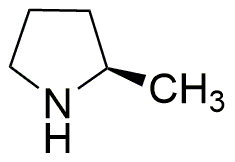(R)-(-)-2-Methylpyrrolidine is widely utilized in research focused on
- Synthesis of Pharmaceuticals: This compound serves as a chiral building block in the synthesis of various pharmaceuticals, enhancing the efficacy and selectivity of drug formulations.
- Organic Chemistry Reactions: It acts as a versatile reagent in organic synthesis, particularly in reactions that require a chiral environment, improving reaction outcomes compared to non-chiral counterparts.
- Ligand in Catalysis: The compound is employed as a ligand in asymmetric catalysis, facilitating the production of enantiomerically pure compounds, which is crucial in the development of new drugs.
- Flavor and Fragrance Industry: It is used in the formulation of flavors and fragrances, providing a unique scent profile that enhances the appeal of consumer products.
- Research in Neuroscience: The compound is studied for its potential neuroprotective effects, contributing to research aimed at developing treatments for neurodegenerative diseases.
General Information
Properties
Safety and Regulations
Applications
(R)-(-)-2-Methylpyrrolidine is widely utilized in research focused on
- Synthesis of Pharmaceuticals: This compound serves as a chiral building block in the synthesis of various pharmaceuticals, enhancing the efficacy and selectivity of drug formulations.
- Organic Chemistry Reactions: It acts as a versatile reagent in organic synthesis, particularly in reactions that require a chiral environment, improving reaction outcomes compared to non-chiral counterparts.
- Ligand in Catalysis: The compound is employed as a ligand in asymmetric catalysis, facilitating the production of enantiomerically pure compounds, which is crucial in the development of new drugs.
- Flavor and Fragrance Industry: It is used in the formulation of flavors and fragrances, providing a unique scent profile that enhances the appeal of consumer products.
- Research in Neuroscience: The compound is studied for its potential neuroprotective effects, contributing to research aimed at developing treatments for neurodegenerative diseases.
Documents
Safety Data Sheets (SDS)
The SDS provides comprehensive safety information on handling, storage, and disposal of the product.
Product Specification (PS)
The PS provides a comprehensive breakdown of the product’s properties, including chemical composition, physical state, purity, and storage requirements. It also details acceptable quality ranges and the product's intended applications.
Certificates of Analysis (COA)
Search for Certificates of Analysis (COA) by entering the products Lot Number. Lot and Batch Numbers can be found on a product’s label following the words ‘Lot’ or ‘Batch’.
*Catalog Number
*Lot Number
Certificates Of Origin (COO)
This COO confirms the country where the product was manufactured, and also details the materials and components used in it and whether it is derived from natural, synthetic, or other specific sources. This certificate may be required for customs, trade, and regulatory compliance.
*Catalog Number
*Lot Number
Safety Data Sheets (SDS)
The SDS provides comprehensive safety information on handling, storage, and disposal of the product.
DownloadProduct Specification (PS)
The PS provides a comprehensive breakdown of the product’s properties, including chemical composition, physical state, purity, and storage requirements. It also details acceptable quality ranges and the product's intended applications.
DownloadCertificates of Analysis (COA)
Search for Certificates of Analysis (COA) by entering the products Lot Number. Lot and Batch Numbers can be found on a product’s label following the words ‘Lot’ or ‘Batch’.
*Catalog Number
*Lot Number
Certificates Of Origin (COO)
This COO confirms the country where the product was manufactured, and also details the materials and components used in it and whether it is derived from natural, synthetic, or other specific sources. This certificate may be required for customs, trade, and regulatory compliance.


